|
|
|
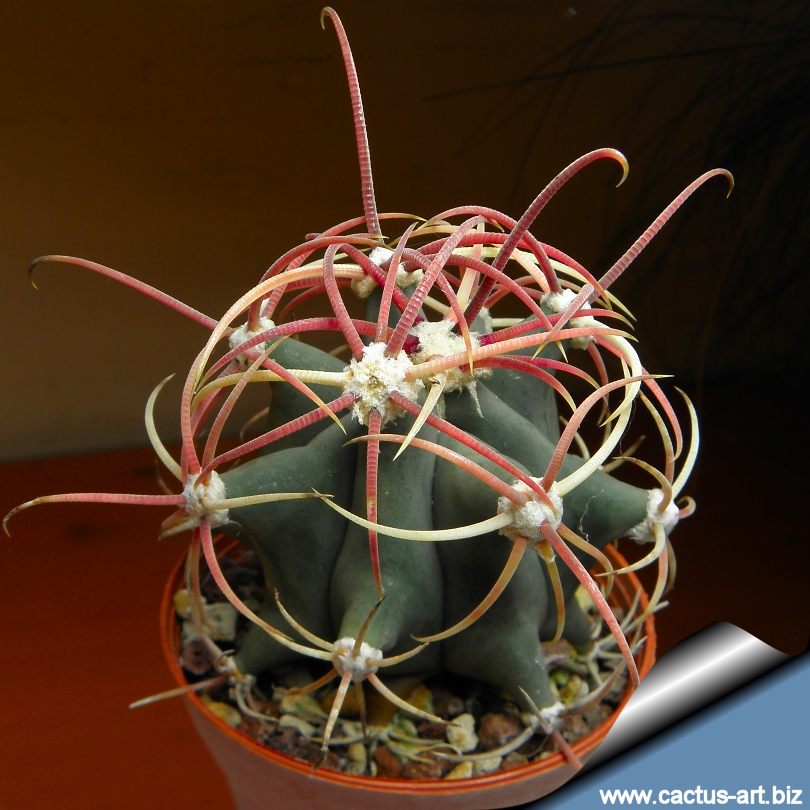
Ferocactus emoryi
Nice looking tall barrel cactus with colourful spines. Grows up
to 2 m tall.
|
|
Description:
F. emoryi is a solitary barrel cactus except in
case of injury to the growing tip, it lacks the lower radial spines of
F. wislizenii and
F. acanthodes but has similar heavy, ridged, hooked central
spines.
Stems: Erect, globular when young to a stout cylinder when older,
30-90(-250) tall × 30-60 (100) cm in diameter; tubercled when young
later forming ribs.
Ribs: (15-)21-32, shallowly notched immediately above each
areole.
Areoles: oval with brown wool, 2-2.5 cm apart.
Spines: 6-10 per areole, reddish, reddish grey, or horn coloured,
all robust and rigid, more than 1 mm diameter.
Central spine: 1, curved slightly to fully hooked, (hooked only
on relatively young plants), heavy, roughly cross-ribbed,
annulate, thick, adaxially flat, 55-95(-130) long × 2.5-4 mm. in
cross section.
Radial spines: 5 to 9 similar to central, spreading, not hooked,
2.5 to 5cm long.
Flowers: Reddish outside, brilliant red inside, 6-7.5 × 5-7.5 cm;
inner tepals brilliant red [or occasionally yellow]; stigma lobes
brilliant red.
Fruits: Persistent, oblong, scaled, 2,5-5cm long × 25-35 mm long
in diameter with the dried remains of the flower atop, ± readily
dehiscent through basal pore, bright yellow, 50, leathery or fleshy,
locule dry, hollow except for seeds. Often the fruit are broken into and
the seed eaten by birds or rodents.
Seeds: 2 mm. in diameter, black.
The 'emoryi'
subspecies can reach a height of 2 m and over 80 cm thick. It has 30 or
more ribs.
The 'rectispinus' subspecies only grows up to about 150cm
high and 50cm thick. It has about 21 ribs and the central spines are
more erect and very long.
|
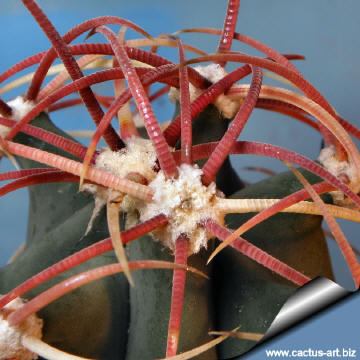 |
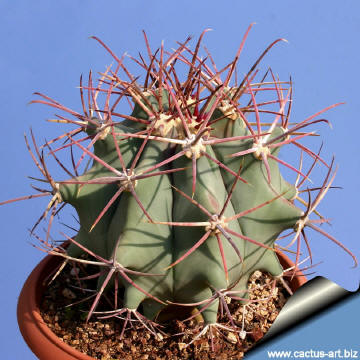 |
|
. |
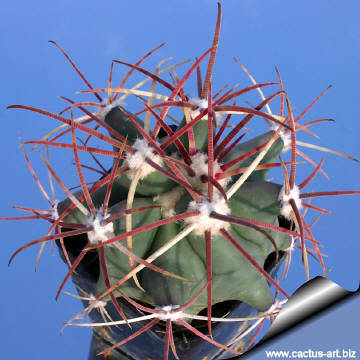 |
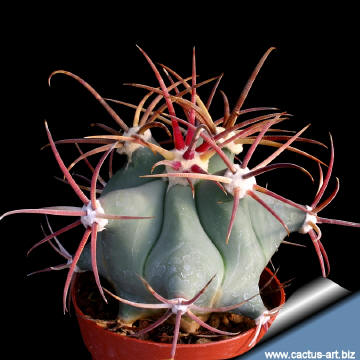 |
|
. |
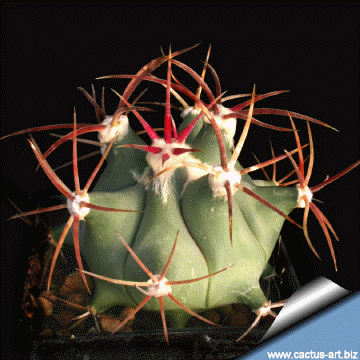 |
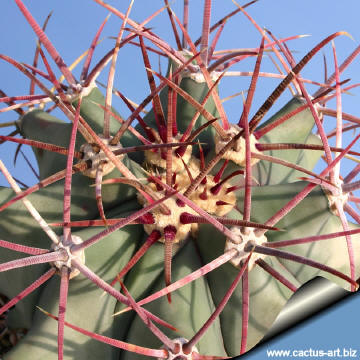 |
|
Advertising
|
|
|
|
Family:
Cactaceae
(Cactus
Family)
Scientific Name: Ferocactus
emoryi ssp. emoryi (Engelmann) Orcutt,
Published in: Cactography. 1926(1): 5. 1926.
Basyonim: Echinocactus emoryi Engelmann
Published in: Proc. Amer. Acad. Arts 3: 275. 1856.
Synonyms:
- Echinocactus covillei Berger1829
- Ferocactus covillei Britton & Rose 1922
Common Names: Emory’s barrel cactus, Coville’s
barrel cactus, Traveler's Friend
Origin: It is native of the lower deserts of Arizona
(Yuma, Pima and Maricopa Co.) and Mexico (Sonora).
Habitat: Hillsides, wash margins, alluvial fans, mesas, or
flats, gravely rocky or sandy soils, rocky slopes and adjacent bajadas,
Sonoran desert scrub, igneous substrates; 0-1200 m; Gravely, sandy, or
rocky soils of hillsides, alluvial fans, and wash margins at 450 to 750m
elevation.
Conservation status: Listed in
CITES appendix 2.
Note: Ferocactus emoryi has a confused taxonomic history.
The name is based on Echinocactus emoryi, which was published
twice by Engelmann, each involving a different species. Engelmann’s
first use of E. emoryi [in W. H. Emory]---applied to a population
of Ferocactus wislizeni in eastern Arizona---is rejected as
provisional and therefore invalid. However, Engelmann’s second use of
E. emoryi was a valid publication, and it unambigously pertains to
the species in southwestern Arizona that Britton and Rose unncecessarily
re-named as Ferocactus covillei. |
|
|
|
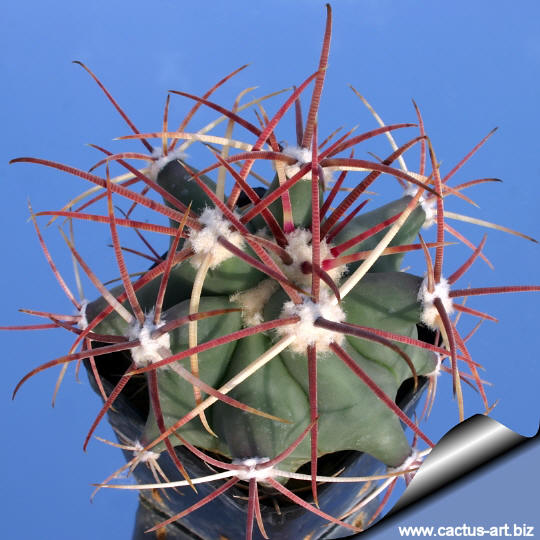
The spines sit on prominent nipples when young which will fade into the
rib with age.
F.
emoryi produce
nectar in the
nectaries at the top of the cactus that feed the
ants that live around its
base. In turn, the ants are very territorial and seem to protect
the plants from other
insects that might try to walk up the
stem and damage the fresh, delicate cells at the growing
apex or steal
nectar or
pollen from the flowers. This strategy is useful to not only to
protect the plant from small
herbivores but also to promote outcrossing pollination because
the only bugs that can successfully visit the flowers without being
attacked by the ants are flying
pollinator insects like butterflies and bees that carry pollen
from other individuals and other
populations, in turn increasing the genetic diversity of the
species.
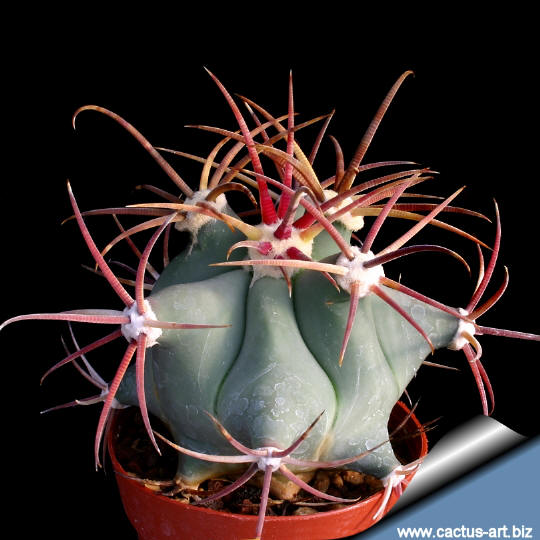
Cultivation: Slow growing to start but does well
under cultivation. Use very
draining soil, water during the aestival growth cycle (this plant
need plenty of water) But needs to be avoided wetting the bodies
of these plants while they are in sunlight. A wet cactus in the sun
light can cause sun burning which can lead to scares or even fungal
infections and death.
Needs full sun. Keep dry at 10°C in winter,
but can tolerate sporadic light frost.
Reproduction:
Seeds are the only way of
reproducing.
Photo of conspecific taxa, varieties, forms and cultivars of
F. emoryi.

 |
|